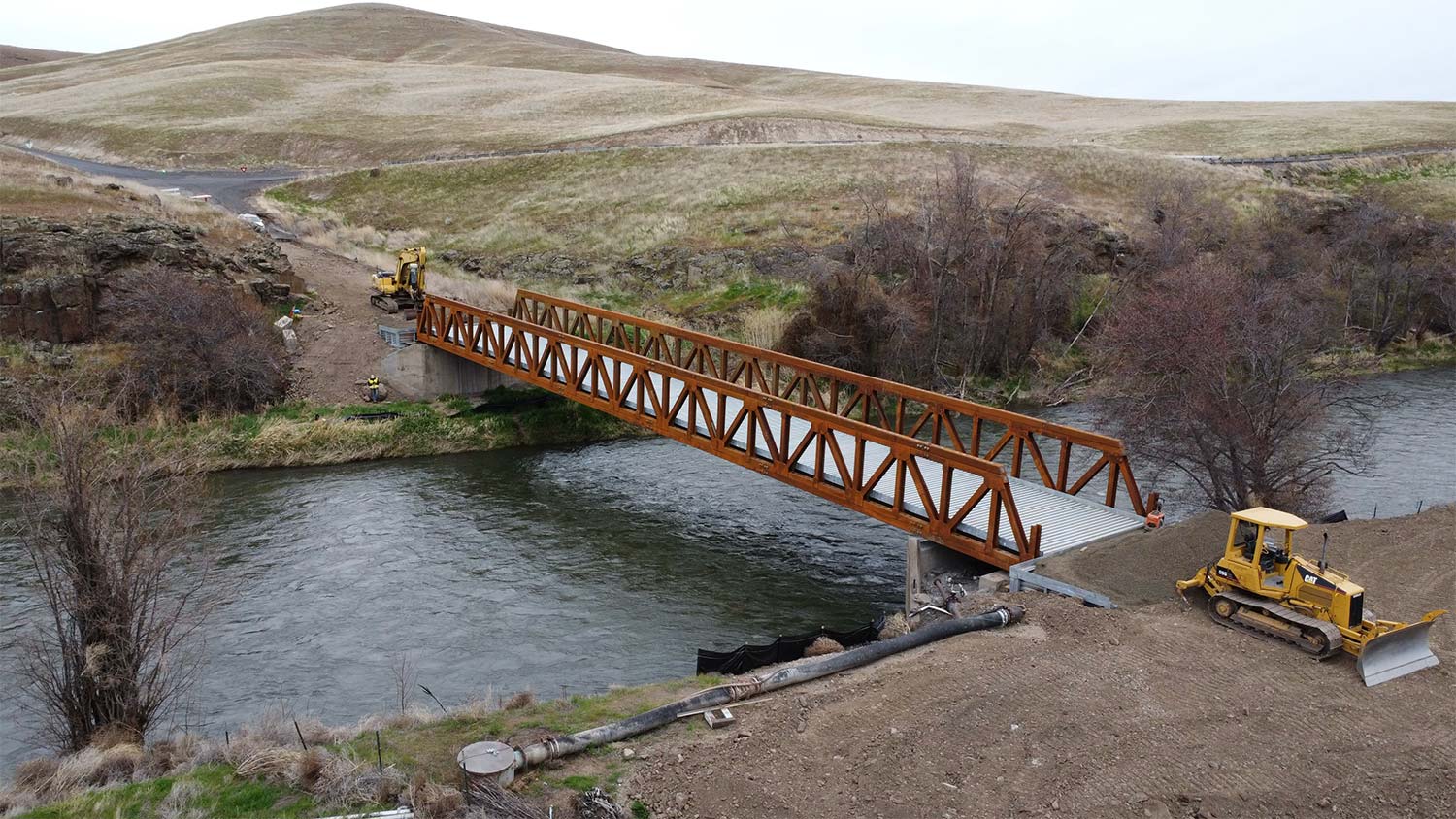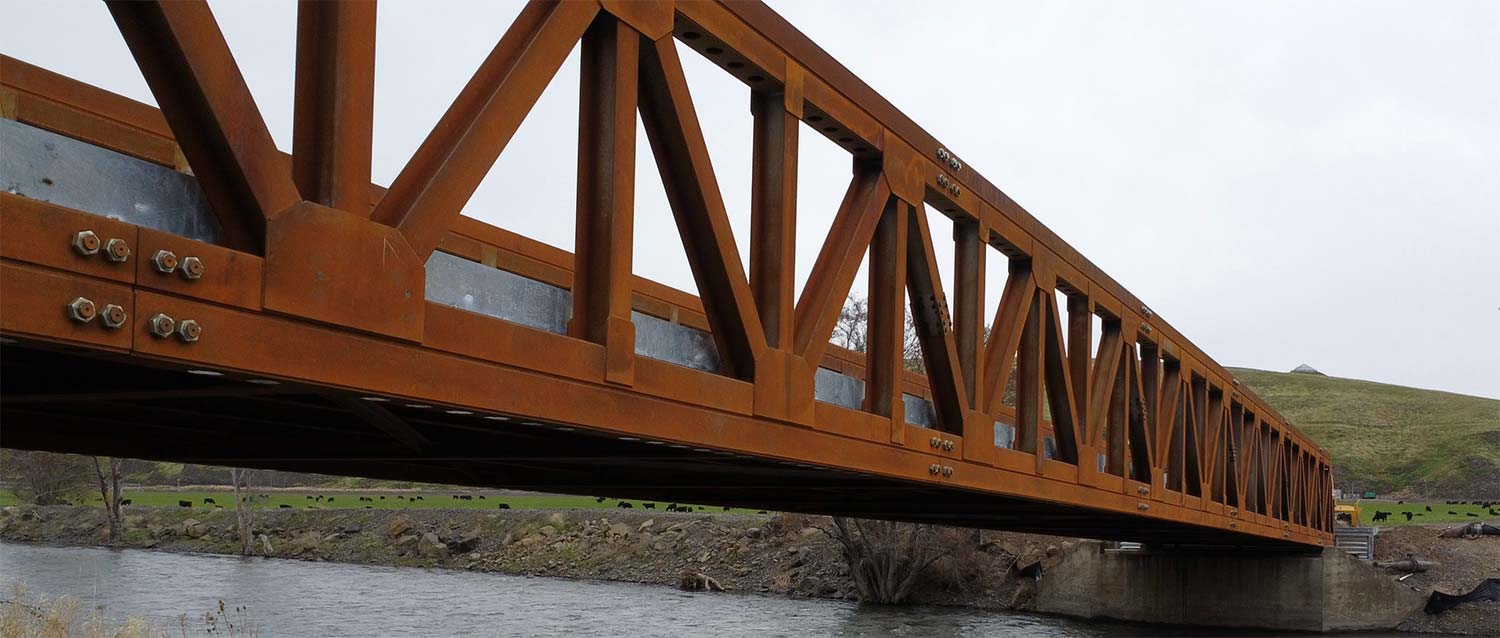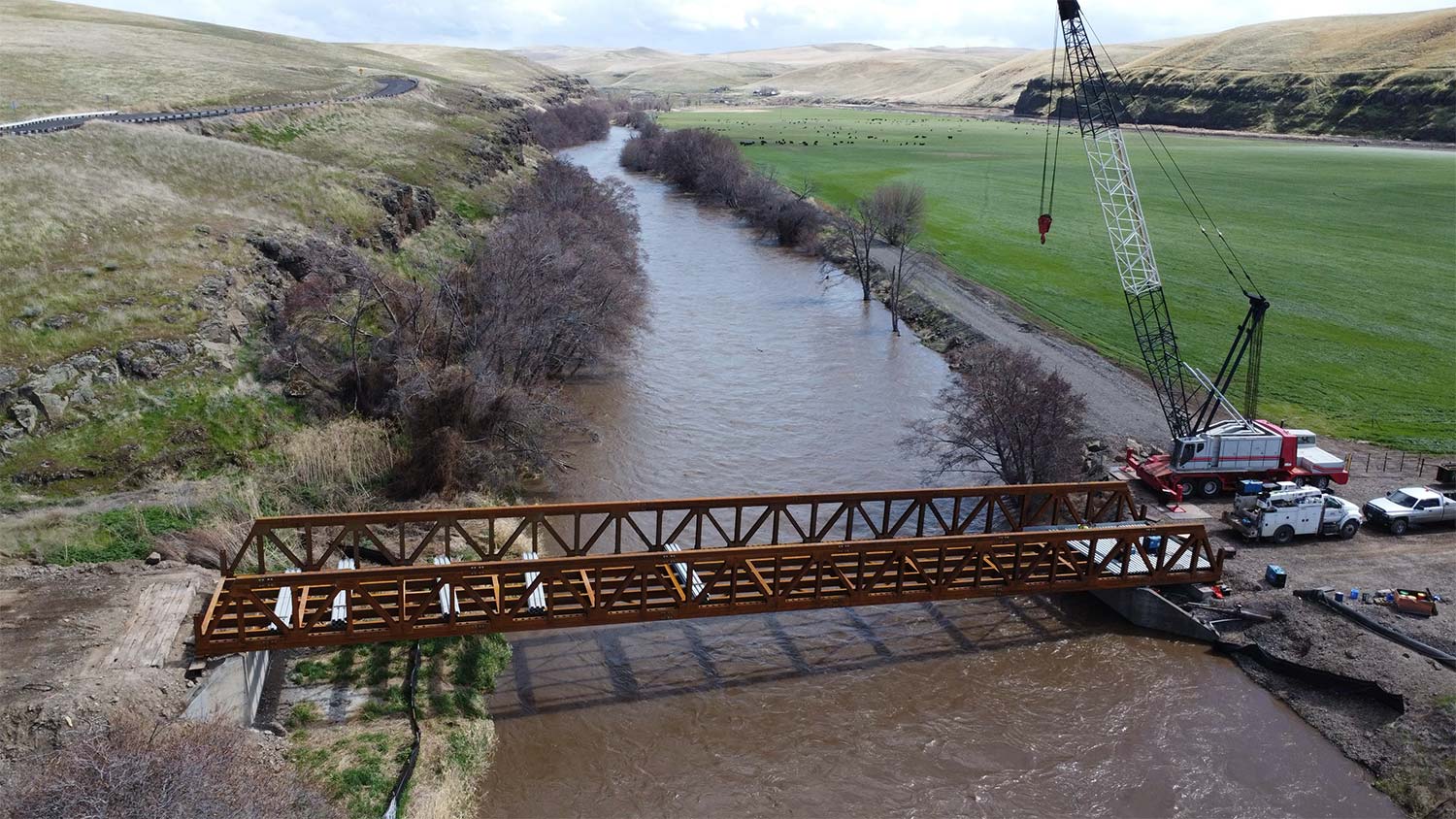Innovative Solutions for Challenging Bridge Projects
“The Mac Hoke Bridge is a permanent bridge solution fabricated and constructed with the speed and economics of a modular system. Fundamentally similar to the WWII Bailey Bridge yet completely modernized.”

Applying 21st century technology to the WWII fundamentals of the Bailey Bridge
The Bailey Bridge concepts, first developed in 1940, were revolutionary at the time: factory fabricated, interchangeable modular components that could meet a range of differing field conditions, and constructable without the need for heavy equipment. The Mac Hoke bridge design modernizes these still relevant concepts to leveraging today’s standards, technologies, and best practice:
-
- Concrete deck
- Permanent bridge rail detail
- A709, Charpy tested steel
- High capacity sections that better fit modern equipment
- Camber for zero deflection at full load
- Zero overhead restrictions
- Purpose Built for Launch Installation
- Advantageous Freeboard

Meeting the Needs of a Complex Remote Project Site
The Mac Hoke Bridge replacement project in Umatilla County is a prime example of how modern design methods can be applied to overcome significant logistical and environmental challenges. By leveraging modular-truss steel bridge technology and accelerated delivery methods, the Rainier Welding project team successfully delivered a 147-foot clear-span bridge in under a year, at an estimated 25% discount to traditional methods.
Overcoming Project Challenges with Design Innovation
Following flood damage, Umatilla County needed a rapid, cost-effective, and durable replacement bridge. The project faced multiple challenges, including:
-
- Remote Location & Limited Access: Due to load-posted bridges in route, All materials had to be transported for the final logistic leg along a 30-kilometer gravel road.
- Environmental Constraints: The site’s location crossing the Umatilla River required that no work be conducted below the mean low lower water (MLLW) level.
- Installation Time Constraints: Migratory swallows necessitated a strict completion deadline before nesting season.
- Permitting Constraints. The Mac Hoke project avoided the need for a USACE 404 Permit by with all work occurring above and outside of MLLW.
- Poor Soils. Bypassing poor soils avoided costly, deep foundations for support or installation.
These factors made traditional construction impractical, necessitating an innovative modular-truss bridge solution.
Watch this short video to see 1) how the bridge aesthetics fit nearby Historic Oregon Trail, 2) the challenging site accessibility, and 3) the environmental constraints (cue the migrating swallows).

The Modular-Truss™ Solution: A Smarter Approach
To address these challenges, the Mac Hoke Bridge was designed as a prefabricated, modular, pin-connected pony truss. This system provided several advantages:
-
- Accelerated Fabrication and Installation: The bridge components, made from 172,000 lbs of A709-50W domestic steel, were fabricated by Rainier Welding in Anacortes, WA, and shop-assembled for quality control before transport.
- Precision Deflection Control: The design and construction provided 3 ½ inches of positive camber, ensuring zero deflection under load.
- Minimized Equipment Needs: Instead of large cranes, a 150-ton lattice boom crane was the largest single piece of equipment used. An underslung guided gantry facilitated the removal of the old bridge and installation of the new one, saving the project an estimated $300,000 in crane costs.
- Efficient Launch Method: The bridge was launched into place on Hillman mountable rollers, eliminating the need for in-water work or large equipment. The rollers also expedited installation.
A Cost-Effective and Durable Outcome
By separating the bridge superstructure design-supply contract from the construction contract, the county enabled a faster and more cost-effective procurement process. Following an agile contracting mechanism, as espoused by DBIA, was helpful. Key results include:
-
- 25% estimated lower total cost.
- Six-month fabrication timeline, with installation completed within three additional months.
- Improved flood resilience: The new design increased freeboard and avoided disturbing existing scour-protection abutments.
- Unlimited color options, although the raw weathered steel look was preferred.
When is a Mac Hoke bridge an attractive option? Let’s make a quick comparison:
| Mac Hoke | Bailey Bridge & other modular bridges | Traditional | |
| Modern Bridge Standards | |||
| Deflection | L/800 to Positive Camber | Sag | Custom, Project Specific |
| Truss | Warren | Double Diamond | Custom, Project Specific |
| Decking | Concrete | Steel or Timber | Concrete |
| Bridge Rails | Permanent, MASH DOT detailing | Temporary Steel Connections | MASH DOT detailing |
| Permitting Requirements | Low | Low | High |
| Span Length | 120’-300’ | 80’-260’ | Varies, Project Specific |
| Design Time | Low Agile Engineering | Low | High |
| Installation Time | Low | Low | High |
| Site Accessibility | Poor+ | Poor+ | Good+ |
| Environmental Impact | Minimal | Good, Minor | Varies, Project Specific |
| Height Restrictions | None | None | Varies, Project Specific |
And who might benefit from the Mac Hoke Bridge approach?
-
- U.S. Forest Service
- Bureau of Reclamation
- County Governments
- Rural, Remote locations
- US Army Corp of Engineers
- Bureau of Indian Affairs
- Department of Transportation
- Heavy Industrial – Oil, Gas, Mining
- Military
Is a contemporary modular-truss bridge the right solution for you? Please contact us if we can be helpful to you in evaluating your needs.
—
Fun Facts: So, who is Mac Hoke?
Mac Hoke was born in Kansas in 1891 and died in Portland, Oregon in 1945. Mac Hoke acquired the Cunningham Sheep Company in 1933 and farmed registered Rambouillet sheep for their fine wool, becoming one of Oregon’s largest wool and wheat producers. Mac’s legacy persists: his descendants still own the business with fewer sheep but more cattle, timber and acreage. Tough businesses. Family businesses that survive multiple generations are rare. Kudos to Mac Hoke and his family. And naming-right-worthy of a cutting edge modular-truss bridge.
